Articles
The Explanatory Power of Climate History for the 19th-Century Maritimes and Newfoundland:
A Prospectus
This article introduces the sources, methods, and groundwork for regional climate history. A reconstruction of 19th-century climate in Halifax, Charlottetown, St. John’s, and the waters of the Maritimes and Newfoundland contributes to understanding the ways that extreme seasonality and climatic variability influenced daily life in the region. Agriculture and transportation were significantly influenced by weather and climate while the experience of backland farmers also illustrates the conjuncture of class, marginal microclimates, poor soils, and human suffering. Despite high climatic variability during the century, the overall pattern is one of annual warming, which continued into the 20th century.
Cet article présente les sources et les méthodes et pose les jalons d’une histoire du climat de la région. La reconstruction du climat d’Halifax, de Charlottetown et de St. John’s ainsi que des eaux des Maritimes et de Terre-Neuve au 19e siècle aide à comprendre comment la saisonnalité et la variabilité extrême du climat influaient sur la vie de tous les jours dans la région. Si la météo et le climat avaient une forte incidence sur l’agriculture et les transports, l’expérience des fermiers de l’arrière-pays était aussi marquée à la fois par la classe sociale, des microclimats marginaux, la pauvreté des sols et la souffrance humaine. Malgré la grande variabilité du climat observée au cours du siècle, on note une tendance générale à un réchauffement annuel, qui s’est poursuivie jusqu’au 20e siècle.
1 CLIMATE HISTORIANS RECONSTRUCT PAST CLIMATIC PATTERNS and short-term weather events, inquire into historic vulnerabilities to variations and extremes of climate, and examine representations and discourses of climate. Narratives of climatic change and regional adaptation are a part of the Atlantic region’s past as well as its present. A more nuanced and more focused account of climatic stability and change in Atlantic Canada during the 19th century can help us better understand the general pattern of settlement and development. What follows is an analysis of the ways that extreme seasonality and variability influenced daily life in the region, accompanied by a reconstruction of 19th-century climate in Halifax, Charlottetown, and St. John’s as well as the waters of the region. The goal of this prospectus is to introduce some of the sources, methods, and groundwork for regional climate history. Further work is required on the impact of weather and climate on agriculture, transportation, fisheries, and lumbering, which will help illuminate the interplay of climate and human agency in creating and responding to periods of dearth and prosperity, war and other conflict, disease, politics, and cultural continuity and change.1
2 As a field, climate history is inherently interdisciplinary and international – reflecting the climate system’s own dynamism and global scale.2 Over the past 45 years, the field of climate history has broadened and deepened its avenues of inquiry, sources of study, and geographical and temporal range. Recent climate history has international precedents in the 19th and early 20th centuries. And between the 1960s and the 1980s, some European scholars, including Emmanuel LeRoy Ladurie, Hubert Lamb, and Christian Pfister, established the templates and impetus for the current field of climate history.3 The research of scholars in myriad social and natural sciences – anthropologists, philosophers, economists, political scientists, climatologists, and geographers among others, who have been motivated in part by current climatic changes – provide evidence of significant interdependence between human endeavours and climatic parameters such as growing seasons, duration of winter, etc. Exciting work in paleogenetics and paleoanthropology yields clear evidence for the importance of climate to the deep human past. Jared Diamond’s 1997 Guns, Germs, and Steel disseminated and popularized understandings of the centrality of geographic and environmental factors – including climate – to the longue-durée histories of human societies, and has raised the profile of these factors in 21st-century world histories.4 Geoffrey Parker’s recent book, Global Crisis: War, Climate Change and Catastrophe in the Seventeenth Century, which is in the Braudelian tradition of the French Annales school, elucidates the critical connections among weather, agriculture, and social order.5 Parker emphasizes agriculture and the vital calories that it yields as a base for understanding tangible links between people and climate. The 17th century saw “an unequalled series of extreme climatic effects,” including two years without a summer and “landmark winters.” Climatic conditions, particularly between 1640 and 1719, contributed to harvest failures, malnutrition, starvation, crises of royal authority, forced relocation, overall population decline, banditry, and general uprisings in Europe, China, the Ottoman Empire, and, to a lesser extent, India. This “fatal synergy between natural and human disasters” was exacerbated by the almost endemic warfare of the period. Climate also intensified the effects of diseases, including, in some cases, their lethality. Adverse weather conditions slowed or prevented transportation by armies, rulers, farmers, merchants, and others. Parker’s insights into the multidimensional interdependence of human and ecological systems prompt questions about the influence of these connections on the history of Atlantic Canada.6
3 The historiography of climate-society relationships in Northeastern North America has been weighted towards the New England states, with some important contributions from Canadians writing about Atlantic Canada. Judith Fingard’s “The Winter’s Tale” is an analysis of the intersections of seasonality, urban poverty, and the development of charitable organizations in cities in the Maritimes. Fingard highlights the disparities in the degree to which climate affected the livelihoods and well-being of urban-dwellers of different social and economic classes. Winter conditions “intensified the underemployment of labour, aggravated illness, and attracted the destitute rural poor to the cities where sufficient wealth, self-interest, and jobbery could be found to sustain charitable relief and public asylums.” Winter conditions also contributed to the development of an informal social safety net within cities, influenced early union organizing, and linked the economies of rural and urban communities.7 Liza Piper’s “Backward Seasons and Remarkable Cold: The Weather over Long Reach, New Brunswick, 1812-1821” draws on her analyses of climate-society relationships and short- and long-term climatic change based on the diary of New Brunswick farmer Benjamin Crawford. Piper argues that some farmers changed their agricultural, economic, and occupational strategies as a way to adapt to the especially unpredictable environmental conditions of the decade.8
4 Piper focuses on the period of unusual cold bracketing the “year without a summer” in 1816 (which followed the 1815 eruption of the Indonesian volcano Tambora), contextualized within the climatic epoch entitled the “Little Ice Age.” The Little Ice Age is defined by glaciologists, geographers, geologists, and climatologists as a period of cooler-than-average temperatures that affected parts of the world for periods between 1200 and the mid-19th to early 20th century.9 European researchers writing in The Iceberg in the Mist: In Search of the Little Ice Age suggest that the 17th century appears to have been the coldest in Europe within the past 1,000 years, while the 19th century “seems to have been the coldest in North America.”10 During that century, many settlers in Atlantic Canada farmed land that was marginal for agriculture in the best of years. William Baron and others, including David Smith, Hal Borns, J. Fastook, and A.E. Bridges, climate history researchers at the University of Maine, argue that “for the farmer in marginal climate locations, both past and present, the growing season is central. Success or failure is often defined by the length of the season, the weather that occurs during it, and the timing of certain natural events.”11 Articles and chapters appraising the agricultural capabilities of Atlantic Canada have frequently addressed the limitations posed by thin soils and short growing seasons.12 Historians and historical geographers have written about the dependence of major industries – including agriculture, forestry, and fisheries as well as the transportation systems on which industries rely – on the high diversity of conditions that characterize the seasonal climates of Atlantic Canada.13 However, the work on climate-society interdependence in the region has been piecemeal.14
5 Descriptions of weather and climate in the Gulf of St. Lawrence region published in contemporary 19th-century newspaper reports and journal articles, colonial meteorological records, and secondary literature suggest ways that agriculture and transportation were influenced by seasonal variability. Halifax, St. John’s, and Charlottetown each had a degree of climatic variability that made it challenging for settlers and administrators to depend on the timing of seasonal changes such as the coming and going of ice or the presence of warm weather. This was especially important in an era in which settlers were occupied with the development of colonial landscapes. Activities such as clearing forests, constructing roads, and growing food were highly influenced by a seasonal and variable climate. To contextualize these difficulties within a regional frame of reference, William Baron and Geoffrey Gordon have argued that the higher degree of variability in dates of first and last frost prior to 1860 “would have made an impact on the risk factor in New England agriculture.”15
6 Snow was a variable and precious resource in the winter and spring seasons. It surfaced the ground to permit some of the smoothest transportation of the year, and was used to insulate houses and cellars. As Frances Beavan noted in the mid-19th century, “much delay and loss is experienced for want of it – the sleighing cannot be done, and wheel carriages cannot run, the roads are so rough and broken with the frost – cold is then more intense, and cellars (the store houses and receptacles of the chief comforts) without their deep covering of snow, become penetrated by the frost, and their contents much injured, if not totally destroyed – this is a calamity that to be known must be experienced.”16 Sleighing on roads of ice and snow was relied upon as both a practical medium of transportation and a form of entertainment. Settlers used sleds, particularly during January and February, to “transport bulky products and certain perishables (such as fresh meat), [which was made easier after] the arrival of a ‘sledding frost’.”17 According to Thomas Haliburton, “six to eight weeks of sledding, in winter, are essential for the transportation of fuel, agricultural produce, materials for making fences, timber for ship building and lumber for exportation.”18 Farmers on the Saint John River in New Brunswick saved on ferry costs by waiting until they could make the crossing on an ice road.19 Skating, curling, and horse races were forms of entertainment that depended on the thickness and quality of ice on rivers, lakes, and coasts.20
7 In addition to temperature, factors including timely warmth, precipitation, and clear skies were central to the success of crops – just as their absence posed challenges to colonial agriculture in other years and at particular times of the year. For instance, Colonel W.J. Myers observed that in 1865 “the rainy, foggy and unsettled weather of May, caused a serious interruption to agricultural operations, compensated, however, to some extent by the impulse given to the grass crop by the warm moisture. . . . In June . . . frost, which occurred in some parts of the Province, did much injury to fruit trees and gardens.” Myers further recorded that “July was the only month entirely free from frost.”21 Given the diversity of microclimates in Nova Scotia, it is possible that some parts of the colony had adequate growing seasons that year. Elevation, though, can exacerbate the vulnerability of certain areas to frost formation.22 Given that lower class farm families tended to live at higher elevations, Myers’s observations suggest that climate often acted with multiple stressors that challenged the survival of backland families first and foremost. They had neither a diversity of crops to rely on, nor an accumulated surplus that could buffer them from one to several years of poor harvests.23 They also lived further from water than their neighbours who farmed the rich riverbank or intervale soils, and hence from water’s small though important moderating effects on the climate as well as its nutritive legacy in the soil.
8 While there were many implications of climate for the settlement and development of the Gulf of St. Lawrence region, climate’s impact was shaped by economic, social, and political factors. As Rusty Bittermann noted in his description of Cape Breton’s mid-19th-century potato crop failures: “The crises were created by nature, as magistrates’ reports and editorials alike agreed, but nature had exposed a social structure where some lived on the margin and others did not.”24 Short and variable growing seasons, as well as pathogens and parasites such as potato blight, wheat rust, and the wheat midge, all of which were affected by climate, challenged the region’s farmers during the 1800s. Thin soils did so as well. These burdens were borne most heavily by backland farm families and by those living on other agricultural edges – be they microclimatic, soil-based, or economic. Poor settlers did not have the surplus crops, land, or other forms of wealth that could buffer them from the combined effects of unfavourable climatic, economic, and political forces. Transportation connections, and the degrees of isolation settlers experienced, were also profoundly affected by the climate. Merchants and settlers involved in the shipping industry and the fisheries, for instance, faced dangers and uncertainties due to the climate’s impact on lives lived at the edges of land and sea, and sea and ice. During the 19th century climate was central in determining when the waters along coasts acted as barriers separating people, and when those same waters provided links connecting them. The same was true as well for the region’s networks of roads and trails. Indeed, the evidence suggests that in many ways the experience of life in the Gulf of St. Lawrence region simply cannot be understood without close attention to climate’s role in shaping the lives, and choices, of those who lived in the region.
9 In order to factor climate adequately into regional historiographic understandings, we need to assemble data that illuminate the historic climates of the region. Depending upon the period being studied, climate historians can draw on natural archives or proxy records such as tree rings, ice cores, and sediment cores or on the documentary and instrumental observations of “colloquial meteorologists” (diarists who were consistently attentive to the vicissitudes of the weather), natural scientists, and formally trained meteorologists.25 Early instrumental records from British, British North American, and Canadian repositories contain a wealth of detailed climatic information. While these require analysis and corrections, they can contribute to a more detailed understanding of the region’s climatic past. Written sources provide indirect evidence of climate through everything from newspaper reports of damages due to storms, to port records from Prince Edward Island, to more subjective and interpretive renderings in letters and poetry. These corroborate and strengthen the anecdotal evidence in the “Climatological Returns” for St. John’s and Halifax, and the Abstracts of Meteorological Registers for Charlottetown.26 Recorded by personnel of the Royal Engineers, these sources include instrumental records of precipitation, temperature, wind direction, etc., as well as commentary on human disease, wild plants, crops, aurora borealis, and other natural phenomena. Written sources also highlight the central role of climate in the experience of colonial and early Canadian settlement and development. Secondary studies of ocean-atmosphere circulation systems, such as the North Atlantic Oscillation (NAO) and the Atlantic Multidecadal Oscillation (AMO), compilations of data pertaining to ice formation and movement, and studies of the correlation between tree-ring growth and ocean-atmospheric systems expand the terms of reference for a study of the character, dynamics, and implications of climate in the 19th century.27 Such studies connect the Gulf of St. Lawrence and its environs to the larger North Atlantic, and Atlantic, worlds. In time, natural archives from sediment cores to tree rings may provide further insight into climates of the regional longue-durée past, and into the climates of recent centuries.
10 Close analysis of fragmentary climate data from specific sites within Atlantic Canada helps us to understand the overall patterns of climate change in the region and their complexity. The aphorism “climate is what you expect, weather is what you get” reflects the conceptualization of climate as based on long-term statistics, while weather is experienced in shorter time periods and can change moment to moment. Following the World Meteorological Organization, Canadian climate “normals” are based on between 18 and 30 years of weather observations, and are reassessed every decade; human experiences of climatic “normality” are based on the continual interaction of memory and expectation, adjustment, and adaptation.28 A multiplicity of climatic cycles, including sunspots and shifts in ocean-atmospheric circulation patterns, follow an interconnected logic that prevents simple comparison across decades. However, decadal-scale analysis of climate during the 19th century allows for comparisons between and among anecdotal sources and the graphs constructed for the Gulf of St. Lawrence and Newfoundland ice projects. What follows is a rough synthesis of the sequential, decade-by-decade, experiential story of climate change in Atlantic Canada during the 19th century.29 Climates within the region were highly variable throughout the century, and a warming trend appeared in the last few decades.
11 The 19th century began with cool summers and mild winters in New Brunswick, which could suggest that ocean-atmosphere circulation patterns were slightly different from those in later years. As well, it could be a reflection of the Dalton solar minimum, or volcanic activity.30 The provincial legislature of Prince Edward Island declared an embargo on the exportation of foodstuffs for eight of the years between 1797 and 1817. According to historical geographer Matthew Hatvany, contemporaries attributed the embargoes to the combination of climatic fluctuation, pest and mice infestations, and insufficient harvests.31 In Nova Scotia, ice filled the Halifax Harbour in 1815, 1817, and 1821. Following the eruption of Mount Tambora in Indonesia in April 1815, 1816 became known as the “year without a summer” or “eighteen-hundred-and-froze-to-death” as it was dubbed within Northeastern North America.32 The impacts of volcanic aerosols circulating in the atmosphere included crop failures, unseasonable snow, food shortages, and the need for government relief.33 Halifax Harbour was obstructed with ice from 1 February to 7 February; on 21 February, the harbour was shut in by ice.34 At Quebec City, the St. Lawrence River was covered “with fixed ice, on the 3d of May” – an event that was believed never to have occurred “within the memory of the longest liver among us.”35 In the 1820s, there were crop failures in Cape Breton. The decade also marked the beginning of sporadically mild winter weather, which was particularly evident in 1824 and 1826. Severe drought in New Brunswick culminated in the Miramichi Fire of 1825, during which a fifth of the province was thought to have burned.36 The New Year’s season of 1830 to 1831 was also remarkably mild, from Quebec to Nova Scotia. However, as a decade, the 1830s was colder than the one previous. Late spring and early fall frosts were responsible for crop destruction on Prince Edward Island in five years out of ten.37 The year 1833 was particularly cold, as evidenced by the reports from Quebec, Prince Edward Island, and Cape Breton. There were reports of frost, ice, and hail in Quebec on 8 and 9 June, and the fall crops withered in the Bras D’Or lakes area of Cape Breton.38 Conversely, in the spring of 1834, Pictou harbour opened on the earliest date on record.39 And winters were especially cold between 1835 and 1839. According to historian John D. Post, 1836 and 1837 were the coldest years between 1816 and 1838 in Williamstown, Massachusetts; he attributed this to the eruption of the Nicaraguan volcano, Cosegüina, in 1835.40 The winter season of 1839 to 1840 was mild, although after 1843 the decade appears to have been cold overall. The region’s farmers also struggled with potato blight from 1844 onwards. Some years it was accompanied by other crop failures and, in Newfoundland, by an unsuccessful fishery. In the mid-to-late years of the decade, the ice in the Gulf of St. Lawrence and on the Scotian Shelf was heavy. Indeed, several of these years ranked among the four points in the century with the highest amount of reported ice according to the graph of “Gulf of St. Lawrence and Scotian Shelf Ice Extent” that appears on the preceding page.
12 The 1850s were characterized by opposite extremes of temperature, as depicted on the graph of gulf ice (see Figure 1).41 Ice formed around Sable Island for four of the ten years, the highest frequency within any decade in the century. The fifties were also punctuated by mild seasons, including the winter of 1854/1855 when Charlottetown harbour remained open until 8 January thus setting a record for latest date of open-water in the winter season for that harbour.42 That spring and summer the growing season mean reached the highest point for seasons consistently recorded in the “Climatological Returns for Halifax,” while in St. John’s the average growing season temperature descended to its lowest point for the same period.43
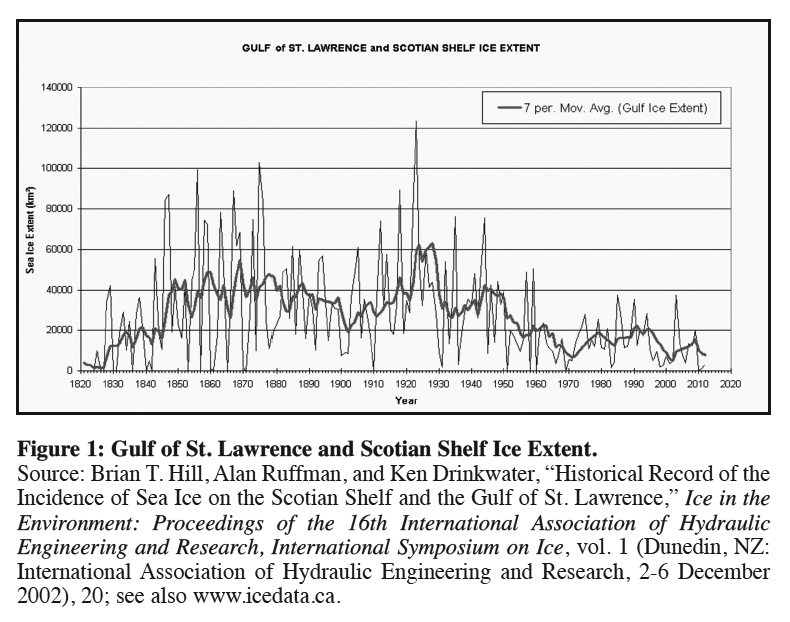 Display large image of Figure 1
Display large image of Figure 1 Display large image of Figure 2
Display large image of Figure 213 The 1860s appear to have had a balance of colder and milder years. Hill, Ruffman, and Drinkwater conclude from their study of the incidence of ice in the Gulf of St. Lawrence that “the approximate 30 year period around the 1860s” appeared to involve extensive ice.
14 The graph of “Gulf of St. Lawrence and Scotian Shelf Ice Extent” (see Figure 1) depicts the 1870s as the last decade with extremely high ice extent until the 1920s. That decade, spring came early (1871) and late (1875). The 1880s were also erratic, with severe winter seasons (Gulf of St. Lawrence, Prince Edward Island, New Brunswick, 1882) and mild ones (Prince Edward Island, 1886). East of Newfoundland, the ice reached its furthest extent for the 19th century circa 1882. The following year, the growing season mean for St. John’s was the highest for the last three decades of the century. The graph depicting the reports of sea ice on Sable Island shows that the 1880s was tied with the 1840s for the second highest frequency of ice formation in these two centuries.
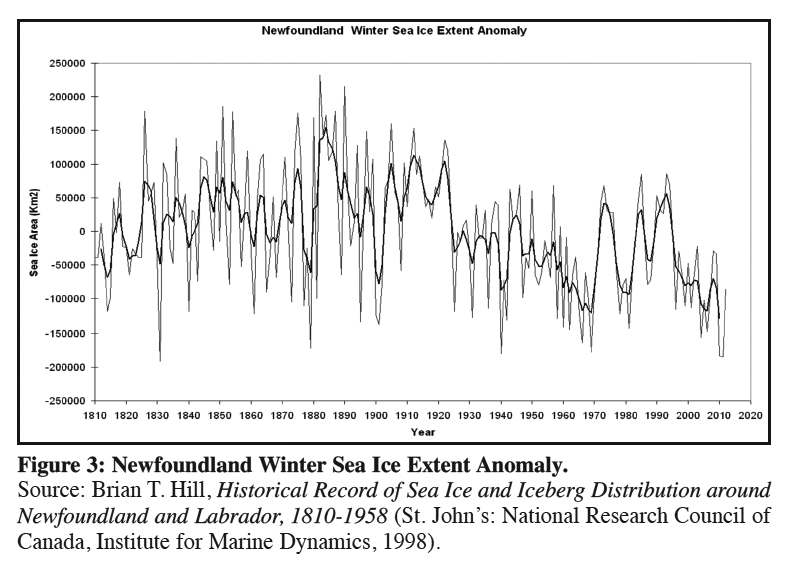 Display large image of Figure 3
Display large image of Figure 3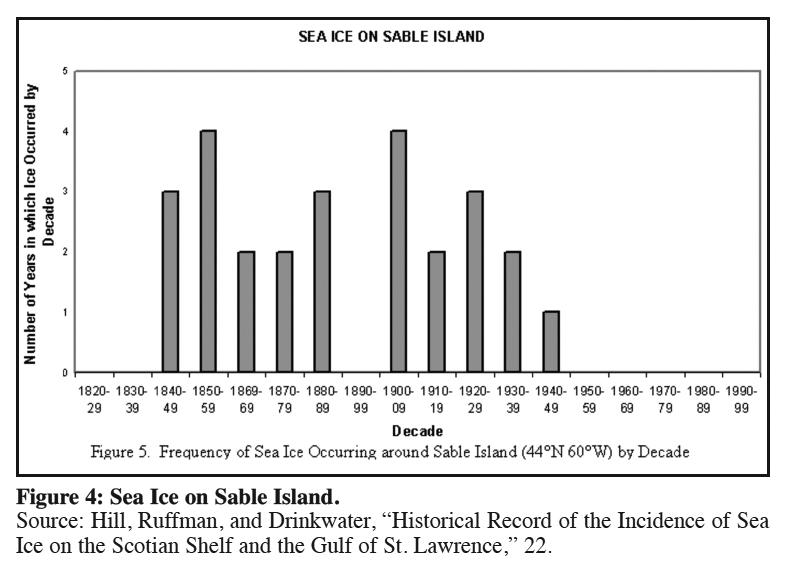 Display large image of Figure 4
Display large image of Figure 415 In the 1890s, opposite temperature regimes were recorded. The winters, overall, trended towards milder temperatures, with less ice formation. The 1890s was the first decade in the “Historical Record of Incidence of Sea Ice for the Scotian Shelf and Gulf of St. Lawrence” database in which ice did not form in the vicinity around Sable Island (although it came close).44 Ice in the Gulf of St. Lawrence was consistently less extensive during this decade than in any other recorded decade of the century. There was heavy ice in the Gulf in 1890, while two years later North Sydney in Cape Breton experienced the first ice-free winter season in living memory. In 1894 spring arrived early, bringing heavy ice into Halifax harbour in May; observers reported that such an ice blockade had not occurred in the previous 42 years. In 1898 the ice off the eastern shore of Nova Scotia was more extensive than usual, although it did not reach as far as Sable Island. The winter of 1898 to 1899 was mild, and the waters around Prince Edward Island were open for much of the season. And Charlottetown’s highest growing season mean in Environment Canada’s historic records occurred in 1899.45 On 1 January 1900, the port of Charlottetown was still open. The Halifax Herald reprinted the news from the Island, including Islanders’ unique appreciation of “the closing year,” when navigation was typically closed as well.46
16 Overall, the balance of evidence suggests that the mid-to-late-19th-century settlement and development of the region occurred in a period characterized by a warming trend as well as by significant short-term fluctuations and changes in the climate.47 Farmers, fishermen, and ships’ captains’ expectations of annual weather were conditioned by a tumultuous and variable climate, and thus their experiences in the 1800s were of multiple scales of change. This tumult was in part a function of topography and distance from the ocean, as proximity and vulnerability to particular weather patterns, including storm tracks, prevailing winds, and ocean currents, is to a large part determined by geography. Timing was also critical to the establishment of agricultural settlements. Farmers do not have 40 years to wait and see whether they can earn a livelihood from the land on which they are homesteading. To what extent, therefore, was the transience of the regional population during this century related to the high degree of variability in the climatic conditions that settlers and their families experienced?48 Change and upheaval were the order of the day, and this required that newcomers adjust their expectations of climate in relation to what they were used to, primarily in the British Isles, as well as in terms of what they experienced in the region from year to year.
17 Further evidence of changing ice formation and movement confirms the overall warming trend of the century. Local expectations that the Halifax harbour would freeze up changed over the century, with freezes occurring once every few years (1815), to once a decade (1839), to once in 20 years (1859).49 In 1889 the river at Bridgewater and the harbour at Pictou were still open on 5 and 7 January respectively, both of which were almost unprecedented dates for open water.50 Blocked harbours precluded direct shipping and transportation, while the extension of the open water season allowed shipment and receipt of products, mail delivery, and the possibility of more diverse transport and commercial connections. In 1894 and 1896, there were reports of unexpectedly early southward movements of ice floes and icebergs, including in January of the latter year the sighting of “an immense iceberg off Cape Race . . . a remarkable occurrence so early in the winter.”51 In 1899, when the SS Northumberland continued traveling “to and from Point de Chene [Pointe-Du-Chêne, New Brunswick] until Christmas,” the Halifax Herald noted “it was remarked upon as breaking all records within the memory of living persons.”52 Although such an assessment that contemporary conditions surpassed “living memory” are considered as “a sort of stock-phrase used frequently in sources . . . and it is questionable how much reliance may be placed upon it,” it retains some significance as a pronouncement on lived experience and social memory.53 In this case, it provides another piece of the pattern of regional warming in the last decades of the century.54
18 The navigation season for Prince Edward Island’s ports as a whole was extended over the course of the 1800s. The minimum length of the season was 196 days in the first half of the century, followed by a minimum length of 214 days in the second. Despite these changes, there were still exceptionally cold years and severe ice throughout the century, with some of the most extensive ice forming in the later decades. In December of 1831 and 1875, for example, Charlottetown’s harbour was frozen earlier than it had been for 20 years previous. In the former year, it was frozen by 13 December, and in the latter year it was frozen by 4 December.55 While the overall trend in average annual temperatures was towards warming between 1873 and 1930, cold conditions continued on a sporadic basis throughout the period – including several remarkably severe winter seasons between 1874 and the late 1890s as well as between 1904 and 1925.
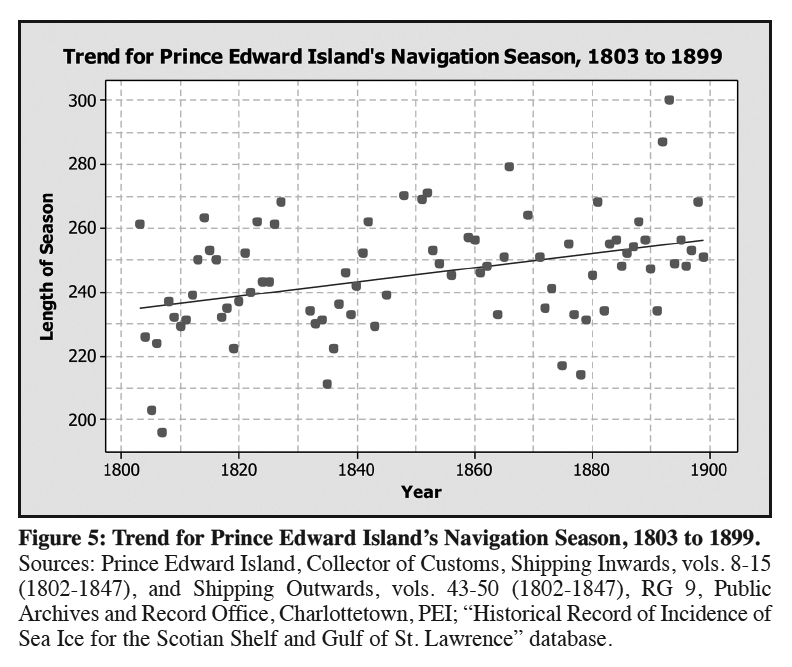 Display large image of Figure 5
Display large image of Figure 519 The complexity of the dynamics of ice formation and movement precludes simple interpretations of their changes over time. The movements and blockades of ice observed near the end of the century could have been due to a change in patterns of atmospheric circulation from the patterns of previous decades. Glaciologist and geographer Jean Grove noted that levels of solar radiation prior to 1882 were lower than was previously thought.56 An increase in solar activity changes the heat balance of the atmosphere, and subsequently the “amount of heat exchange between ice, water, and air.”57 Changes in these parameters influence the movements of storm tracks, weather systems (or systems of high and low pressure), the ocean-atmospheric circulation, and the densities of ocean water.58 There are, as well, a host of meteorological and oceanographic features that can influence coastal ice formation, including the predominance of cold Arctic air or of warmer low pressure systems from the south, the strength and direction of the winds, the bathymetry or depths of the Gulf of St Lawrence and coastal shelves, and the water currents, tidal forces, and tidal streams of the region.59 According to G. Robinson, a harbour master in St. John’s, the older ice masters perceived that, overall, seasons were milder and the ice seasons less severe after 1860.60 Targeting certain sources, such as the early instrumental records in regional newspapers identified by historical climatologist Victoria Slonosky, could be an efficient way to expand the data base for developing an understanding of 19th century climatic changes and factors.61
20 Diverse sources suggest that despite the continued formation of extensive ice fields in the winter months, the severity of this season generally decreased. The historical evidence suggests that milder and shorter winters became more common by the end of the century than they had been during the early decades of the century. Yet opposite extremes of temperature, ice conditions, and phases of circulation regimes – all of which are interconnected – existed in close temporal proximity. Annual temperatures in Charlottetown, Halifax, and St. John’s trended upward between the early 1870s and c. 1930. Analyses of growing season temperature trends for the same period, however, reveal that Charlottetown was the only location at which the growing season warmed. Analyses also illuminate a high degree of variability in growing season temperatures from year to year and across the decades – from between 2.48° C in Halifax to 3.98° C in St. John’s. Growing seasons in Halifax and St. John’s cooled between 1870 and around 1930, perhaps in relation to the specific phases of the AMO and the NAO – the coupled ocean-atmospheric circulation systems that appear to have a degree of influence on the climates of all three cities.62
 Display large image of Figure 6
Display large image of Figure 6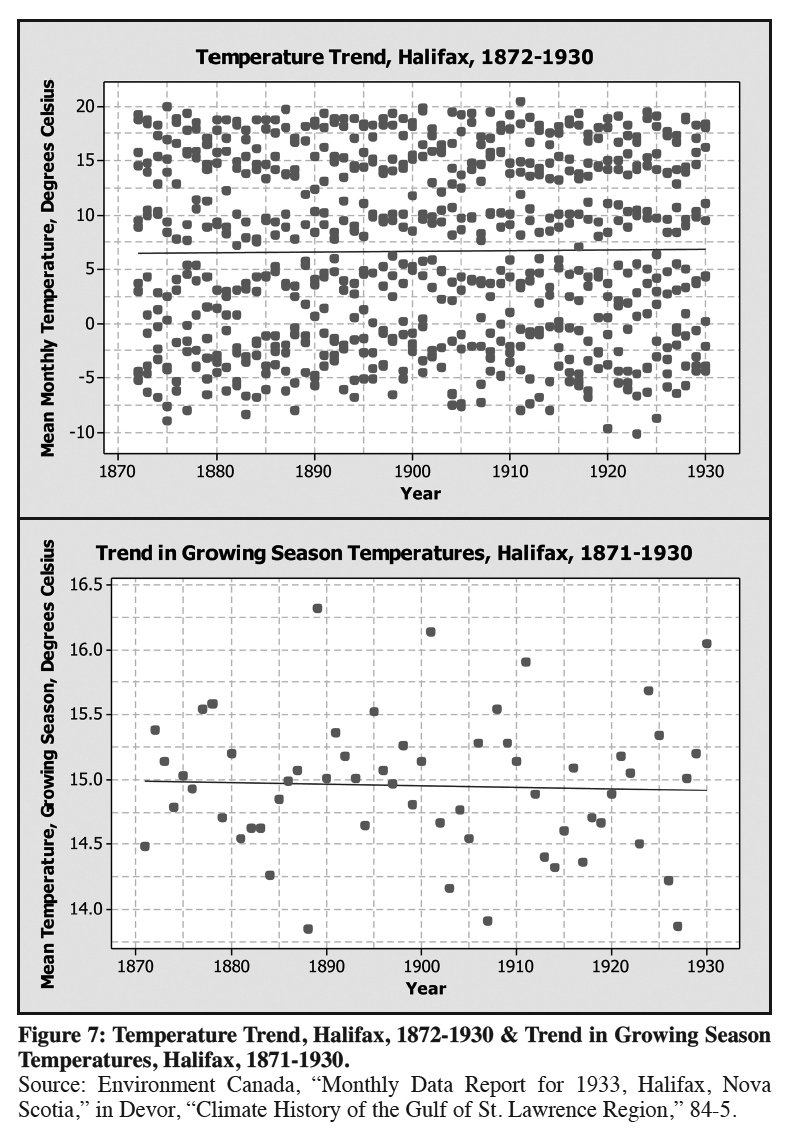 Display large image of Figure 7
Display large image of Figure 7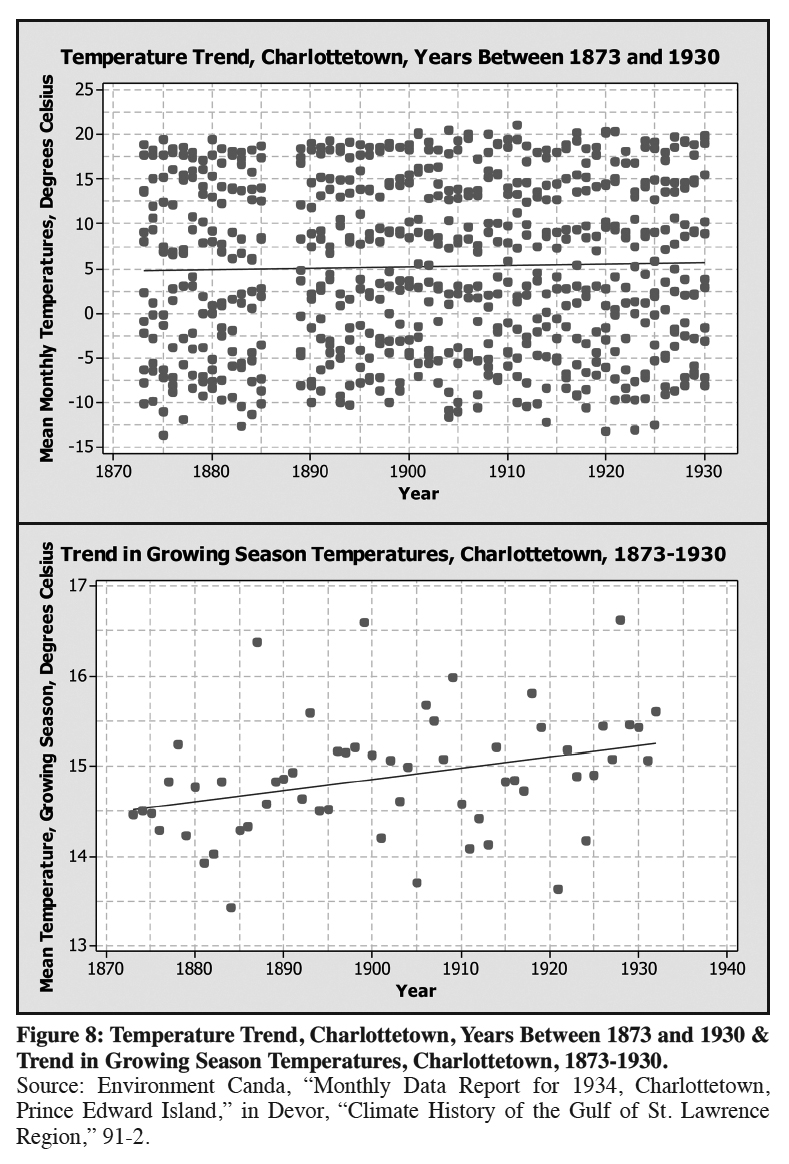 Display large image of Figure 8
Display large image of Figure 821 The trend towards annual warming fits within regional and national patterns, as well as with global changes. A study of regional temperature trends between 1870 and 1989 identifies warming at nine locations, which included the three discussed here.63 As of 2005, the open water season for the St. John River at Fredericton was “about 60 days longer than in the early 1800s.”64 In a study of records from the northeastern United States, historian William Baron observes that in most cases “the warming trend leading into the early twentieth century began sometime during the 1870s.” Retired professor of meteorology Bill Danielson notes that the growing season in the region around Sydney, Cape Breton, was ten days longer in 2007 than it was 100 years prior.65 The pattern of warming in Atlantic Canada fits within the national context, which involved warming that began in the late 19th or early 20th century. Cynthia Wilson’s analyses of Hudson’s Bay Company records from Northern Canada provide evidence of warming after the 1870s. The ice season on the Great Lakes diminished by one to two months between 1857 and 2007. Glaciers in Western Canada began to retreat in the late 19th century, and Arctic glaciers began to melt in 1920.66 Mean global temperatures (including land temperatures and sea surface temperatures) rose by 0.85°C between 1880 and 2012.67
22 Any understanding of the climate history of the region is limited by the available sources. The sources for the history of 19th-century Atlantic Canada demonstrate overlapping patterns of flux. That much is certain. Climatic averages, however, gloss over the crucial elements of the timing of warm or cool weather, its correspondence with particular forms of precipitation, and daily minimum and maximum temperatures. Plants do not grow in average conditions; each has its own specific growing season requirements and associated vulnerabilities. Researchers analysing changes in growing season length argue that the duration of the season at a single station might not have statistical relevance to regional change, or that it may indicate changes that would not be fully appreciated by observers.68 There is evidence, however, that farmers in New Brunswick adapted agricultural practices to difficult climatic conditions in the first half of the 19th century. Benjamin Crawford, a farmer in Long Reach, shifted after 1816 – “the year without a summer” – from an emphasis on hay-reliant cattle to sheep as the latter could subsist predominantly on oats. In the 1830s in the Upper St. John Valley, including part of northeastern Maine, farmers responded to the conjuncture of crop failures, wheat midge and rust, longer winters, and new imports of cheap flour by growing less wheat and increasing their production of oats and buckwheat.69 More sustained and fine-grained analyses are required to determine the significance of growing season variability over the short- and long-term. As well, temperature trends need to be correlated with patterns in other climatic parameters such as precipitation. The ice studies also have their limitations, as they contain none of the meta-data about how and why observations were made and reported or not reported. As well, they are not exhaustive. Given the paucity of early records, for instance, how likely is it that there was no ice around Sable Island in the 1830s, a decade during which there were volcanic dust veils in the atmosphere, and early and late frosts in Prince Edward Island in 5 out of 10 years? How did the number of potential observers in a given year, the communications systems and technology, and the accumulated lessons of history (recent and longue-durée social memory) about areas to avoid, influence the number of ice sightings in particular locales?70 How reliable or accurate are these dates of ice formation as proxies of climatic change?71 And why did some years and decades show agreement between the weather in Halifax and St. John’s while other years and decades showed such divergence?72 The uniqueness of microclimates within the region, as well as the amount and type of evidence available for the locales that were the focus of this study, make generalizations problematic at some levels. It is necessary to study a greater number of sites in order to learn more about the particular dynamics of climate within the region.
23 Some 56 years ago, historical geographer Andrew Hill Clark noted that “despite the environmental limitations of early Nova Scotia, the Acadians ‘chose among alternatives’ in developing their ‘distinctive geographical entity in its own corner of the new world’.”73 The regional literature is rich with observations such as this. The field of climate history thus reflects continuity with earlier work on Atlantic Canada, as well as trends in international literature. Furthermore, it offers a crucial contribution to understanding causation and agency in regional history. Climate history can help us understand important connections and contingencies within the region, as well as situate it within world history.